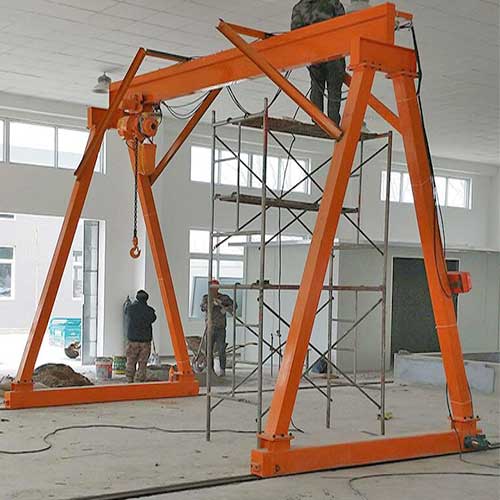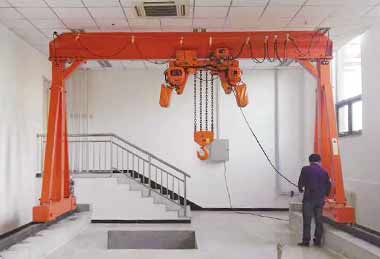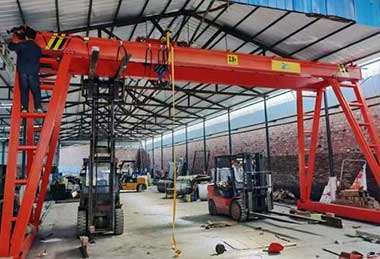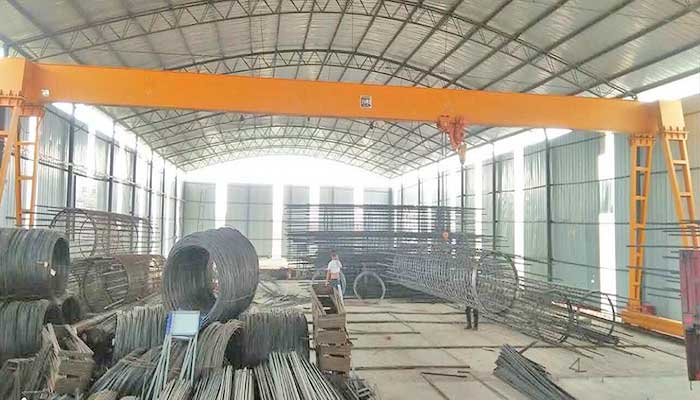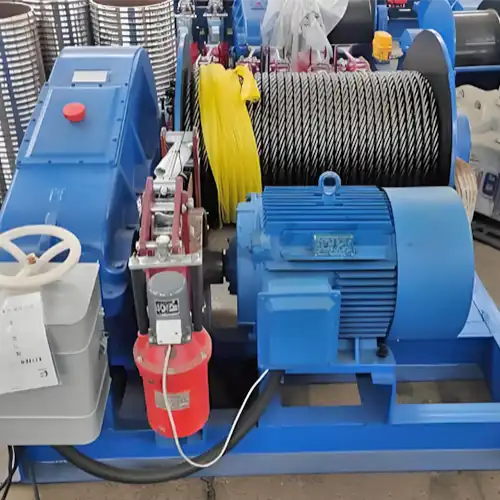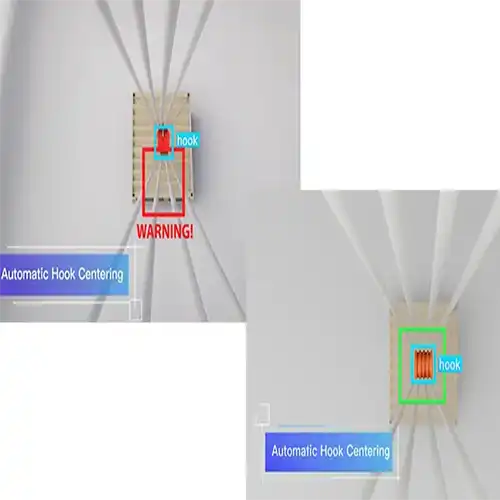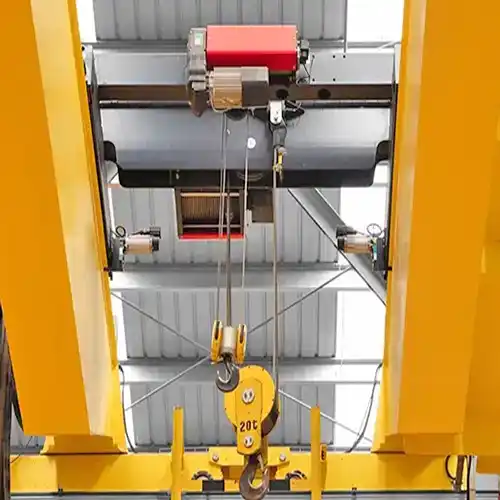Light Rail Gantry Cranes for Confined Workspaces1 T, 3 T, 5T, 10 T
1 ton to 5 tons light rail gantry cranes on tracks for handling small machinery components in compact workshops & assembly lines. Design small crane now!
| Rail crane type | Light rail gantry crane |
| Capacity of crane | 1 ton to 10 ton |
| Lifting Height | As your request |
| Crane Span | As your request |
Category: Crane on Rail
Your Trusted Overhead Crane on Rail Manufacturer & Supplier
Light Rail Gantry Cranes for Confined Workspaces1 T, 3 T, 5T, 10 T
1 ton to 5 tons and up to 10 ton light rail gantry cranes on tracks for handling small machinery components in compact workshops & assembly lines. Design small crane now!
Mastering Efficiency in Confined Workspaces: The Role of Light Rail Gantry Cranes
In the intricate dance of industrial operations, where precision and space optimization are paramount, the choice of material handling equipment becomes a critical factor. Among the myriad options available, light rail gantry cranes emerge as the unsung heroes of confined workspaces, seamlessly navigating tight corners and narrow aisles. This blog delves into the world of these agile champions and explores their significance in conquering the challenges posed by restricted industrial environments.
Efficient material handling is the heartbeat of any productive industrial setting, and the stakes are heightened when confined workspaces come into play. The ability to maneuver within limited areas while maintaining optimal productivity is a game-changer. It not only enhances the workflow but also directly impacts the bottom line by reducing downtime, increasing throughput, and ensuring the safety of both personnel and valuable equipment.
Enter the spotlight: Light rail gantry cranes on tracks, a specialized breed designed to master confined workspaces with finesse. Unlike their heavier counterparts, these cranes offer a unique blend of mobility and precision, making them the ideal choice for compact workshops and assembly lines. Their defining feature lies in their ability to traverse on a lighter rail system, enabling quick, nimble movements that are tailored to the demands of confined industrial environments.
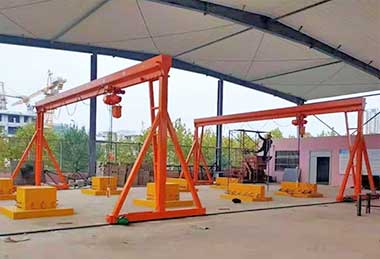
Duel light rail gantry cranes on same tracks for long and tandem operation
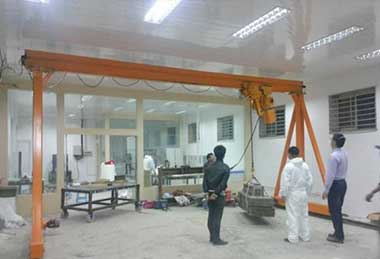
Low headroom light rail gantry crane in cleanroom use with low profile electric hoist
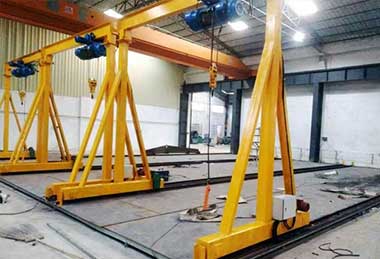
Wire rope electric hoist light rail gantry cranes, cost-effective crane price
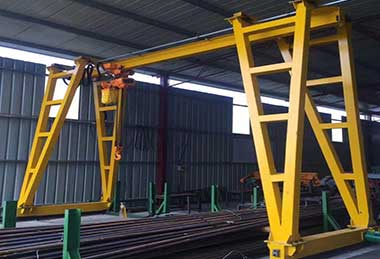
Low clearning light gantry crane for steel production workshops
Key Features of Light Rail Gantry Cranes
Light rail gantry cranes represent a specialized class of material handling equipment meticulously crafted to excel in confined workspaces. These cranes, mounted on tracks, boast a design that prioritizes agility and precision. Unlike their bulkier counterparts, light rail gantry cranes are tailored for applications where spatial constraints demand a delicate touch.
Advantages of Using Light Rail Gantry Cranes in Confined Spaces
- Optimized Space Utilization:The compact design of light rail gantry cranes ensures minimal space wastage, making them ideal for environments where every square meter counts.
- Maneuverability and Flexibility:Engineered for navigating tight spaces with ease, these cranes can adeptly maneuver around obstacles, facilitating efficient material handling in areas with limited clearance.
- Enhanced Productivity:The nimble nature of light rail gantry cranes translates to quicker cycles, reducing the time it takes to move loads within confined workspaces. This, in turn, boosts overall productivity.
- Tailored for Precision:Designed to handle smaller loads with finesse, these cranes are well-suited for industries requiring precise positioning and delicate handling of components and subassemblies.
Mobility and Flexibility in Navigating Tight Workspaces
- Rail System Design:Light rail gantry cranes feature a lighter rail system that enables swift movement along predefined tracks. This design choice optimizes mobility without compromising stability.
- Tight Turning Radius:The cranes' ability to navigate with a tight turning radius allows them to traverse through narrow aisles and negotiate confined corners, providing unparalleled flexibility in spatially restricted areas.
- Adaptability to Varied Layouts:Whether it's a compact workshop with intricate machinery or an assembly line with limited space, these cranes can adapt to diverse layouts, ensuring seamless integration into existing industrial setups.
Safety Features and Considerations
- Overload Protection:Light rail gantry cranes are equipped with sophisticated overload protection systems, preventing the crane from lifting loads beyond its rated capacity and ensuring operational safety.
- Emergency Stop Mechanism:A crucial safety feature, the emergency stop mechanism allows for immediate halting of crane operations in case of unforeseen circumstances, mitigating potential risks.
- Limit Switches:Precision is augmented by limit switches that define the permissible range of crane movement, preventing unintended collisions and enhancing overall safety.
- Collision Avoidance Systems:Inherent safety is further reinforced with collision avoidance systems, which use sensors and advanced technology to detect obstacles, reducing the risk of accidents during crane operation.
As we navigate through the intricacies of light rail gantry cranes, the focus on safety and precision underscores their suitability for the demanding environments of confined workspaces. In the next section, we'll delve into the specific loads these cranes are designed to handle and their typical applications. Join us as we unravel the capabilities of TrackNimble technology in the heart of industrial efficiency.
Typical Loads Handled
In the intricate world of industrial production, small machinery components and subassemblies form the building blocks of larger, complex systems. These components, ranging from intricate gears to specialized electronic parts, are characterized by their modest size and often intricate designs.
Examples of Typical Loads in Compact Workshops
- Precision Components:Small gears, bearings, and machined parts that require careful handling and precise placement within the assembly process.
- Electronics Subassemblies:Delicate electronic components, circuit boards, and subassemblies that demand a controlled and gentle approach to avoid damage.
- Tooling and Fixtures:Compact tools and fixtures used in manufacturing processes, where precise positioning is crucial for seamless production.
- Automotive Parts:Small automotive components, such as sensors, actuators, and connectors, which are integral to the functionality of modern vehicles.
Importance of Tailored Solutions for Specific Loads
- Preserving Component Integrity:Small machinery components often have intricate designs and can be sensitive to rough handling. Tailored solutions ensure the preservation of component integrity during material handling processes.
- Efficiency in Assembly Lines:Tailoring the crane to handle specific loads enhances the efficiency of assembly lines, reducing downtime and streamlining the manufacturing process.
- Minimizing Risk of Damage:Specialized solutions minimize the risk of damage to delicate components, reducing the likelihood of defects and ensuring the production of high-quality end products.
How Light Rail Gantry Cranes Are Designed to Handle Such Loads
- Precision Controls:Light rail gantry cranes are equipped with precision control systems that allow operators to maneuver loads with accuracy, placing components and subassemblies exactly where they are needed.
- Adaptable Attachments:These cranes often come with customizable attachments and specialized hooks designed to securely lift and transport small loads without causing damage.
- Variable Speeds:Adjustable hoisting speeds and smooth acceleration and deceleration capabilities contribute to the gentle handling of loads, minimizing the risk of jolts or shocks during lifting and lowering.
- Fine-tuned Positioning:The design of light rail gantry cranes allows for fine-tuned positioning of loads, ensuring that components are placed precisely in the assembly process without the need for secondary adjustments.
As we unravel the tailored capabilities of light rail gantry cranes in handling specific loads, it becomes evident that their application goes beyond mere material transport. These cranes serve as precision tools in the hands of operators, contributing to the seamless orchestration of intricate manufacturing processes. Join us in the next section as we explore the diverse applications of these compact champions in real-world industrial settings.
Typical Crane Application
Overview of Compact Workshops and Assembly Lines
Compact workshops and assembly lines form the crucible of precision manufacturing, where every square meter is a valuable asset. These environments, often characterized by confined spaces and intricate machinery setups, demand a tailored approach to material handling to ensure seamless workflow and optimal productivity.
Challenges Posed by Confined Workspaces
- Limited Maneuverability:Tight corners and narrow aisles pose challenges for traditional, larger cranes, restricting their ability to move freely within the workspace.
- Spatial Constraints:Compact workshops often have limited floor space, requiring a careful balance between equipment size and the need for efficient material handling.
- Precision Placement:Assembly lines dealing with small components demand precise positioning, which becomes challenging in confined spaces where larger cranes may struggle to navigate with finesse.
Role of Light Rail Gantry Cranes in Optimizing Workflow
- Agile Maneuverability:Light rail gantry cranes, with their nimble design and ability to navigate tight spaces, play a pivotal role in optimizing workflow by swiftly moving through the intricacies of compact workshops.
- Space Optimization:The compact nature of these cranes ensures that they don't encroach on valuable floor space, allowing for efficient utilization of the available area.
- Enhanced Efficiency:By overcoming the challenges posed by confined workspaces, light rail gantry cranes contribute to enhanced efficiency in material handling, reducing waiting times and facilitating a continuous flow of production.
- Streamlined Assembly Processes:In assembly lines, the precision controls and adaptable features of these cranes streamline the placement of components, minimizing the risk of errors and contributing to a more streamlined manufacturing process.
Real-World Examples of Successful Crane Applications in Compact Environments
- Electronics Manufacturing:In electronics assembly, where miniature components demand careful handling, light rail gantry cranes have proven invaluable in efficiently moving and placing delicate circuit boards and subassemblies.
- Pharmaceutical Production:Compact workshops in pharmaceutical facilities often require the precise handling of small vials, packaging materials, and lab equipment. Light rail gantry cranes ensure the swift and accurate movement of these critical components.
- Aerospace Component Assembly:In the aerospace industry, where precision is non-negotiable, these cranes navigate the confined spaces of workshops with ease, facilitating the assembly of small yet intricate components for aircraft and spacecraft.
- Automotive Subassembly Lines:In automotive manufacturing, light rail gantry cranes are utilized in subassembly lines for handling small automotive parts, contributing to the efficiency and accuracy of the overall production process.
As we explore the real-world applications of light rail gantry cranes, their adaptability and effectiveness in diverse industrial settings become apparent. These examples underscore the instrumental role these compact champions play in overcoming the challenges posed by confined workspaces. Join us in the next section as we delve into the specific tonnages these cranes are designed to handle and the implications for their application.
Typical Tonnages Used
In the realm of crane capacity, tonnages refer to the maximum weight a crane is capable of lifting and handling. This crucial parameter determines the suitability of a crane for specific applications, ensuring that it can effectively manage the loads prevalent in a given workspace.
Range of Tonnages (1 Ton to 5 Tons) for Light Rail Gantry Cranes
- 1 Ton to 5 Tons:Light rail gantry cranes are designed with a tonnage range spanning from 1 ton to 5 tons. This makes them particularly well-suited for handling smaller loads in confined workspaces where precision and finesse are paramount.
- Tailored for Specific Applications:The tonnage range reflects a deliberate engineering choice, aligning the cranes with the needs of industries dealing with small machinery components and subassemblies.
Matching Tonnage to Specific Workspace Requirements
- Precision Load Handling:The tonnage capacity of light rail gantry cranes ensures that they are optimally matched to the weight of the loads they handle. This precision is crucial in applications requiring delicate material handling.
- Adaptability to Workspace Constraints:Matching tonnage to specific workspace requirements is essential for efficient material handling in confined environments. Light rail gantry cranes with a 1 to 5-ton capacity strike a balance between strength and precision, making them adaptable to a variety of industrial settings.
Case Studies Illustrating the Effectiveness of Different Tonnages in Confined Spaces
- Small Component Manufacturing:In a compact workshop producing intricate machinery components, a 2-ton light rail gantry crane efficiently handles the lifting and positioning of small parts, contributing to a streamlined production process.
- Electronics Assembly Line:A 3-ton light rail gantry crane proves instrumental in an electronics assembly line, where delicate circuit boards and electronic subassemblies require careful handling to prevent damage.
- Automotive Subassembly:For an automotive subassembly line dealing with small yet heavy components, a 5-ton light rail gantry crane showcases its prowess in lifting and transporting loads with precision and reliability.
- Textile Machinery Workshop:In a confined workspace dedicated to manufacturing textile machinery components, a 1-ton light rail gantry crane provides the agility needed to navigate tight spaces while efficiently handling lighter loads.
These case studies exemplify the versatility of light rail gantry cranes across different tonnages in addressing the specific needs of confined workspaces. The carefully calibrated tonnage capacities enable these cranes to excel in various industries, showcasing their effectiveness in optimizing material handling operations. Join us in the concluding section as we explore the attractive title that encapsulates the essence of these compact champions – "TrackNimble: Light Rail Gantry Cranes Mastering Confined Workspaces."
Light Rail Gantry Cranes vs. Standard Rail Gantry Cranes
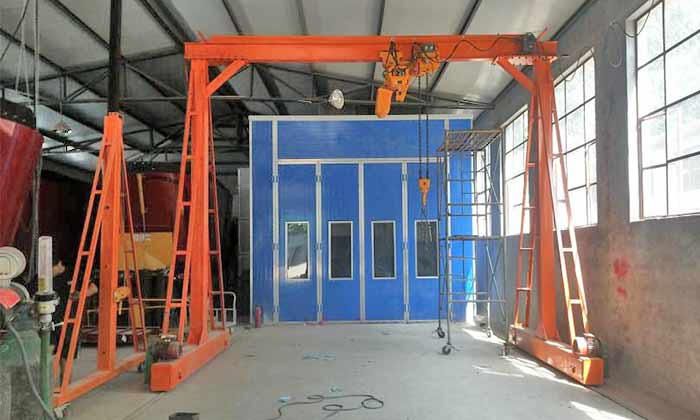
Small gantry crane , a type of portable gantry crane, with simple gantry crane design, cheaper price than standard single girder gantry crane
Mobility and Flexibility:
Light Rail Gantry Cranes:
Designed for enhanced maneuverability in tight spaces.
Utilizes a lighter rail system, enabling quick and agile movement.
Well-suited for compact workshops and assembly lines with limited space.
Standard Rail Gantry Cranes:
Generally larger and heavier, requiring more substantial rail infrastructure.
Suited for larger industrial settings with ample space for crane movement.
May have limitations in confined workspaces due to size and weight.
Load Handling and Capacity:
Light Rail Gantry Cranes:
Typically designed for smaller loads, ranging from 1 ton to 5 tons.
Ideal for handling small machinery components and subassemblies.
Tailored for applications where precision and finesse are crucial.
Standard Rail Gantry Cranes:
Capable of handling heavier loads, often exceeding 5 tons.
Suitable for lifting and transporting larger equipment and materials.
Provides higher lifting capacities for industrial-scale operations.
Cost and Installation:
Light Rail Gantry Cranes:
Generally more cost-effective in terms of both equipment and installation.
Requires less extensive rail infrastructure, reducing overall expenses.
Faster installation due to the simplicity of the rail system.
Standard Rail Gantry Cranes:
Typically involves higher upfront costs for both crane and rail installation.
Requires a more robust rail structure to support heavier loads.
Installation may take longer due to the complexity of the system.
Adaptability to Confined Spaces:
Light Rail Gantry Cranes:
Specifically designed for efficient operation in confined workspaces.
Navigates through narrow aisles and tight corners with ease.
Optimizes space utilization in compact industrial environments.
Standard Rail Gantry Cranes:
May face challenges in confined spaces due to their size and turning radius.
Better suited for open, spacious facilities where movement is less restricted.
May require additional considerations for layout planning in tight areas.
Application and Industry Focus:
Light Rail Gantry Cranes:
Ideal for industries with smaller-scale assembly and manufacturing processes.
Commonly used in workshops, small factories, and specialized production lines.
Provides efficient material handling solutions in limited workspace scenarios.
Standard Rail Gantry Cranes:
Preferred in heavy industries such as steel, shipbuilding, and large-scale manufacturing.
Suited for handling substantial loads in expansive production facilities.
Widely used in applications where high lifting capacities and durability are paramount.
Technology and Innovation:
Light Rail Gantry Cranes:
Often incorporates advanced technologies for precise control and monitoring.
Embraces innovations such as smart sensors and automation for improved efficiency.
Continual advancements focused on enhancing agility and responsiveness.
Standard Rail Gantry Cranes:
Integrates robust technology for heavy-duty applications.
Commonly equipped with advanced safety features and control systems.
Innovations primarily revolve around improving load capacity and reliability.
Maintenance and Operational Considerations:
Light Rail Gantry Cranes:
Generally requires less maintenance due to lighter loads and components.
Operator-friendly interfaces for ease of use and efficient daily operations.
Regular inspections focus on precision components and safety features.
Standard Rail Gantry Cranes:
Maintenance requirements may be higher due to the heavy-duty nature of operations.
Comprehensive maintenance schedules and thorough inspections are crucial.
Operators undergo specialized training for handling larger loads and complex machinery.
In conclusion, the choice between light rail gantry cranes and standard rail gantry cranes depends on specific industrial needs, space constraints, and load requirements. Light rail gantry cranes excel in confined workspaces with smaller loads, providing agility and cost-effectiveness. On the other hand, standard rail gantry cranes are robust solutions for heavy industries with larger-scale operations that demand higher lifting capacities and durability. Each type has its advantages, and the decision should be based on a careful analysis of the unique requirements of the industry or application.
Custom Rail Gantry Cranes for Your Needs
When selecting rail gantry cranes for your specific application, several key parameters must be considered to ensure the optimal performance, safety, and efficiency of the crane. Here are the main parameters to consider:
- Lifting Capacity: Determine the maximum weight of the loads that the crane will be required to lift and move. Choose a rail gantry crane with a lifting capacity that comfortably exceeds the heaviest load expected in your operation.
- Span and Track Length: Specify the distance between the rail tracks, known as the span. Additionally, consider the total length of the rail tracks required. The span and track length are crucial for ensuring that the crane covers the entire working area efficiently.
- Height of Lift: Define the maximum height to which the crane needs to lift the loads. This parameter is essential to ensure that the crane provides sufficient vertical reach for your specific application.
- Duty Cycle and Frequency of Use: Evaluate how frequently the crane will be in operation and the intensity of its use. Different duty cycles, such as light, moderate, heavy, or severe, are available to match the crane's design to the operational requirements.
- Speeds (Hoisting, Trolley Travel, and Bridge Travel): Specify the required speeds for hoisting, trolley travel, and bridge travel. The speed parameters influence the efficiency of material handling and the overall productivity of the crane in your facility.
- Control System: Choose a control system that aligns with your operational preferences and safety requirements. Options include pendant control, radio remote control, or a cabin with a full control panel. Consider advanced control features for improved precision and automation.
- Environment and Conditions: Take into account the environmental conditions of the workspace, such as temperature, humidity, and potential exposure to corrosive substances. Ensure that the crane is designed to withstand the specific conditions of your facility.
- Safety Features: Prioritize safety features, including overload protection, emergency stop buttons, limit switches, and collision avoidance systems. Compliance with industry safety standards is essential to create a secure working environment.
- Rail System: Decide on the type of rail system that suits your facility. Light rail gantry cranes may use a different rail system than standard rail gantry cranes. Consider factors such as rail size, material, and installation requirements.
- Power Supply: Choose the appropriate power supply for the crane, considering factors such as voltage, frequency, and power source. This ensures compatibility with the electrical infrastructure of your facility.
- Installation and Site Requirements: Assess the installation requirements, including the need for any additional civil work, foundation specifications, and space constraints. Ensure that the crane design aligns with the available workspace.
- Customization Options: Check if the manufacturer provides customization options to tailor the crane to your specific needs. This may include specialized hooks, attachments, or additional features based on the nature of your loads.
- Budgetary Considerations: Establish a budget for the rail gantry crane project, taking into account not only the initial purchase cost but also maintenance, operational, and potential future upgrade costs.
By carefully considering these parameters, you can select a rail gantry crane that aligns with your operational requirements, enhances efficiency, and ensures a safe and productive material handling process in your facility.
Wrap it Up
On light rail gantry cranes used in confined workspaces, let's recap the key points that underscore the significance of light rail gantry cranes in industrial applications:
- Efficiency in Confined Spaces: Light rail gantry cranes are purpose-built for confined workspaces, offering a unique combination of mobility, precision, and adaptability.
- Tailored for Small Loads: With a tonnage range of 1 to 5 tons, these cranes are tailored for the nuanced handling of small machinery components and subassemblies.
- Agility and Versatility: "TrackNimble" aptly captures the agility and versatility of these cranes, showcasing their ability to navigate tight spaces and optimize workflow.
Summary of the Advantages of Light Rail Gantry Cranes in Confined Workspaces
- Optimized Workflow: Light rail gantry cranes excel in optimizing workflow by swiftly navigating confined spaces, reducing downtime, and enhancing overall efficiency.
- Space Utilization: The compact design of these cranes ensures efficient space utilization, making them ideal for industries where every inch matters.
- Precision Material Handling: Tailored controls and adaptable features enable precise material handling, crucial for industries dealing with small and delicate components.
In conclusion, as industries continue to evolve and adapt, the role of light rail gantry cranes becomes increasingly pivotal. The light rail gantry cranes offers a pathway to mastering confined workspaces and elevating material handling to new heights. It's an investment in precision, adaptability, and the future of industrial excellence. Contact us to learn more on what we can do to save your limited space used light rail gantry cranes.
Related Products

Latest project
150 Ton Overhead Crane Installation Feedback – Paraguay Case
QDX 150 ton overhead crane in action in Paraguay. Installation photos, video, and client feedback show performance, safety, and heavy-lifting efficiency.
Free consultation to Confirm Parameters & Specifications and Get
Latest Crane Price & Crane Rate.
- Types of overhead cranes : _______?
- Optional: Overhead travelling crane, goliath gantry crane,Slewing jib crane, Single girder or double girder crane,small portable crane or kbk crane, etc.
- Capacity of overhead crane: _______?
- Optional: 0.25ton, 0.5 ton, 1 ton, 2 ton, 3ton, 5 ton, 10 ton,15ton, 20ton, 25 ton, 30ton,35ton, up to 550ton, etc.
- Crane span & lifting height : _______?
- Crane travelling length : _____?
- Control of overhead crane:_______?
- Optional: pendant/ remote/cabin control
- Voltage supply of overhead crane:_____?
- Eg,: 380V50/60HZ,3Phase or others,etc.
- Application/usage of crane:_______?
- Eg,: Steel mill, ,injection mold, cement,stone, concrete,granite, general manufacturing, etc.
Just leave a message via the contact form and our hoist and crane engineer will contact you with in 24working hours.
Get In Touch
